Advanced Applied Management: Auckland Tourism Sector Analysis Report
VerifiedAdded on 2020/03/01
|17
|2792
|77
Report
AI Summary
This report provides a comprehensive analysis of Auckland's tourism sector, examining its current state, its contribution to the city's economy, and the impact of seasonal changes, particularly during the winter months. The research investigates various strategies to develop tourism, including blogger outreach, modern websites, and online mediums. The report outlines the research objectives, questions, and methodology, including descriptive investigation, realism philosophy, and a deductive approach. Data collection methods include both primary (surveys and interviews) and secondary sources (literature review). The analysis employs a mixed-method approach, combining qualitative and quantitative techniques. The report also addresses ethical considerations and limitations, such as accessibility issues, potential data loss, biased responses, time management constraints, and ethical concerns related to data privacy. The conclusion highlights the challenges faced by the tourism industry during the winter season and emphasizes its vital role in supporting Auckland's economic structure.
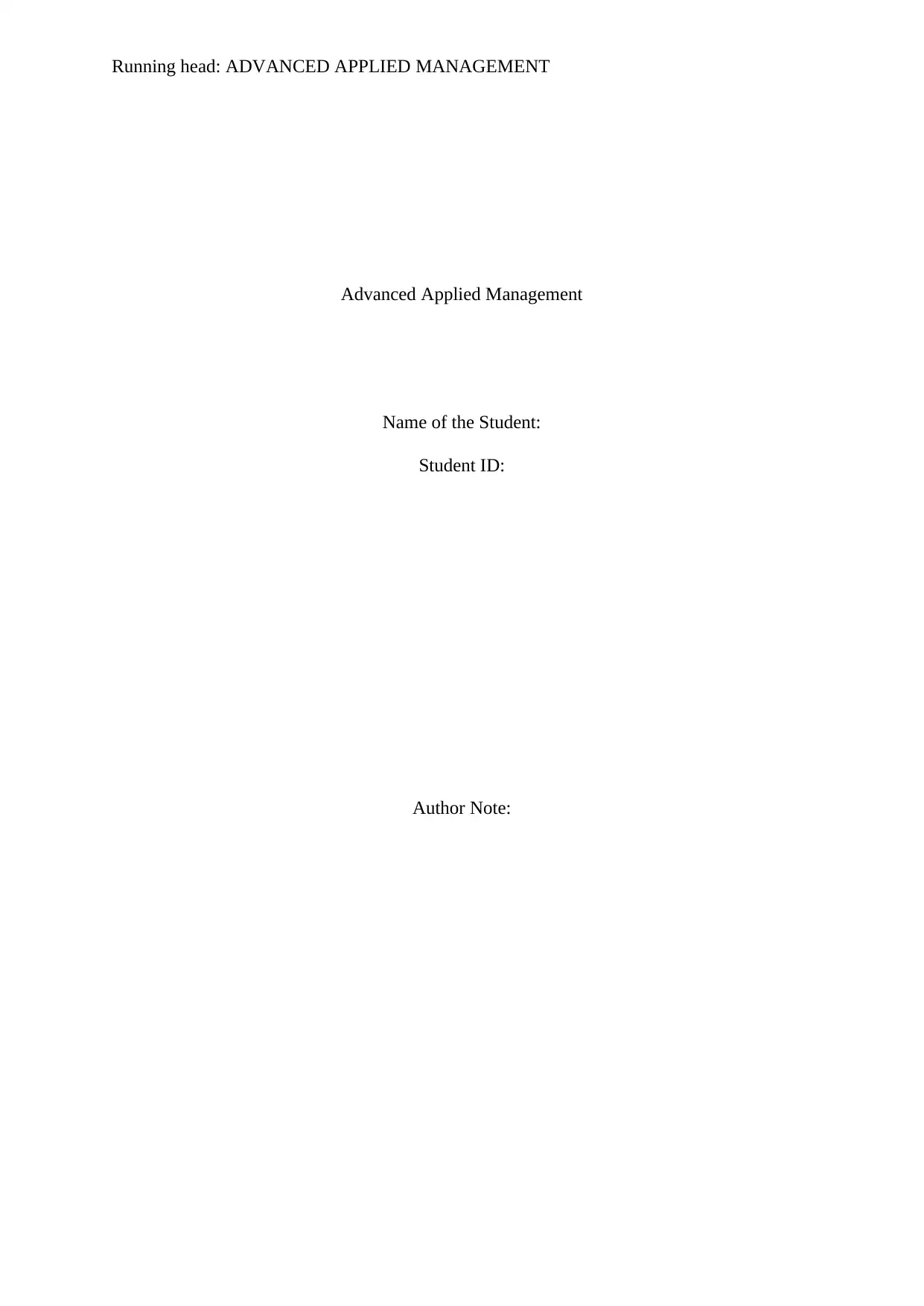
Running head: ADVANCED APPLIED MANAGEMENT
Advanced Applied Management
Name of the Student:
Student ID:
Author Note:
Advanced Applied Management
Name of the Student:
Student ID:
Author Note:
Paraphrase This Document
Need a fresh take? Get an instant paraphrase of this document with our AI Paraphraser
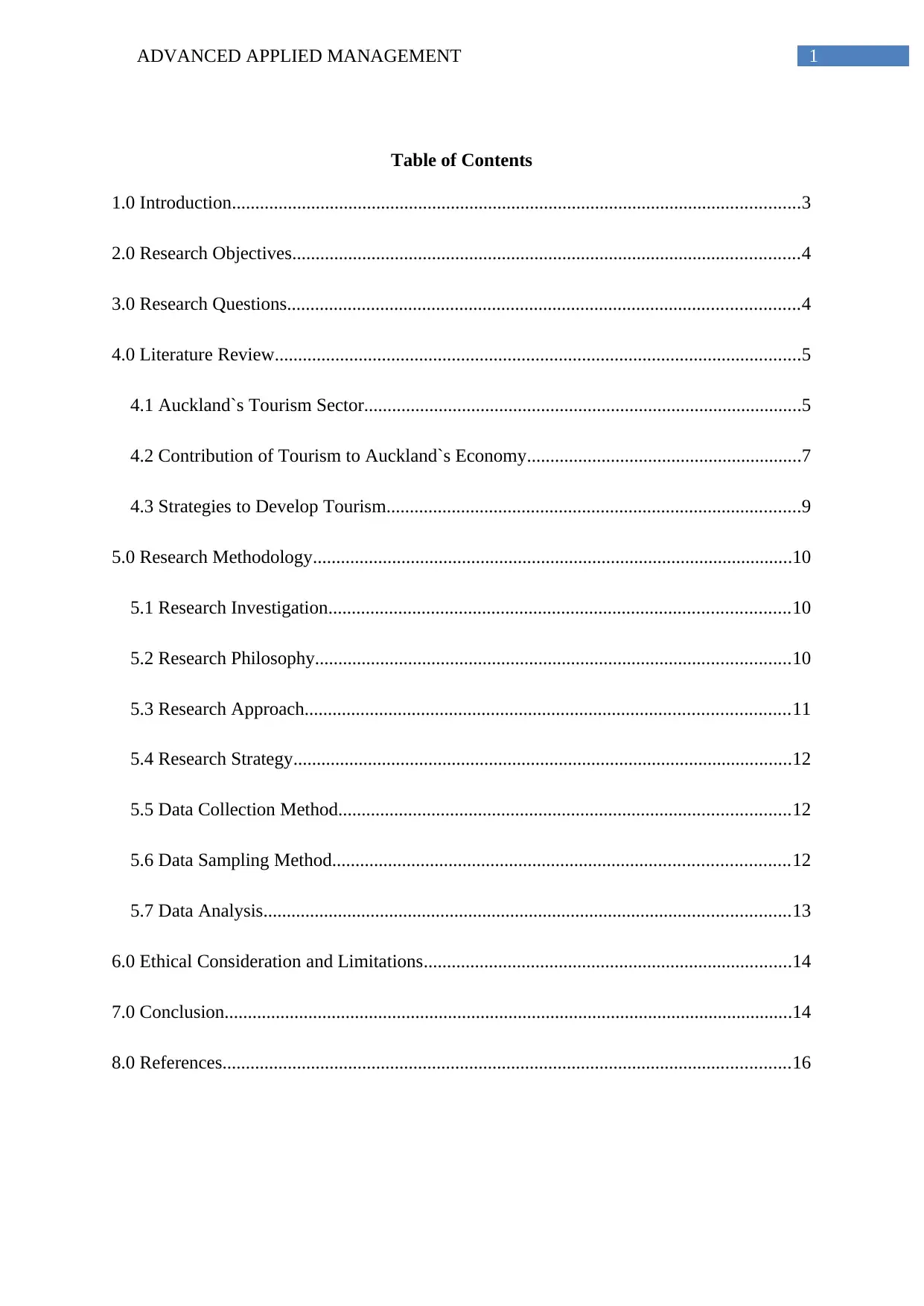
1ADVANCED APPLIED MANAGEMENT
Table of Contents
1.0 Introduction..........................................................................................................................3
2.0 Research Objectives.............................................................................................................4
3.0 Research Questions..............................................................................................................4
4.0 Literature Review.................................................................................................................5
4.1 Auckland`s Tourism Sector..............................................................................................5
4.2 Contribution of Tourism to Auckland`s Economy...........................................................7
4.3 Strategies to Develop Tourism.........................................................................................9
5.0 Research Methodology.......................................................................................................10
5.1 Research Investigation...................................................................................................10
5.2 Research Philosophy......................................................................................................10
5.3 Research Approach........................................................................................................11
5.4 Research Strategy...........................................................................................................12
5.5 Data Collection Method.................................................................................................12
5.6 Data Sampling Method..................................................................................................12
5.7 Data Analysis.................................................................................................................13
6.0 Ethical Consideration and Limitations...............................................................................14
7.0 Conclusion..........................................................................................................................14
8.0 References..........................................................................................................................16
Table of Contents
1.0 Introduction..........................................................................................................................3
2.0 Research Objectives.............................................................................................................4
3.0 Research Questions..............................................................................................................4
4.0 Literature Review.................................................................................................................5
4.1 Auckland`s Tourism Sector..............................................................................................5
4.2 Contribution of Tourism to Auckland`s Economy...........................................................7
4.3 Strategies to Develop Tourism.........................................................................................9
5.0 Research Methodology.......................................................................................................10
5.1 Research Investigation...................................................................................................10
5.2 Research Philosophy......................................................................................................10
5.3 Research Approach........................................................................................................11
5.4 Research Strategy...........................................................................................................12
5.5 Data Collection Method.................................................................................................12
5.6 Data Sampling Method..................................................................................................12
5.7 Data Analysis.................................................................................................................13
6.0 Ethical Consideration and Limitations...............................................................................14
7.0 Conclusion..........................................................................................................................14
8.0 References..........................................................................................................................16
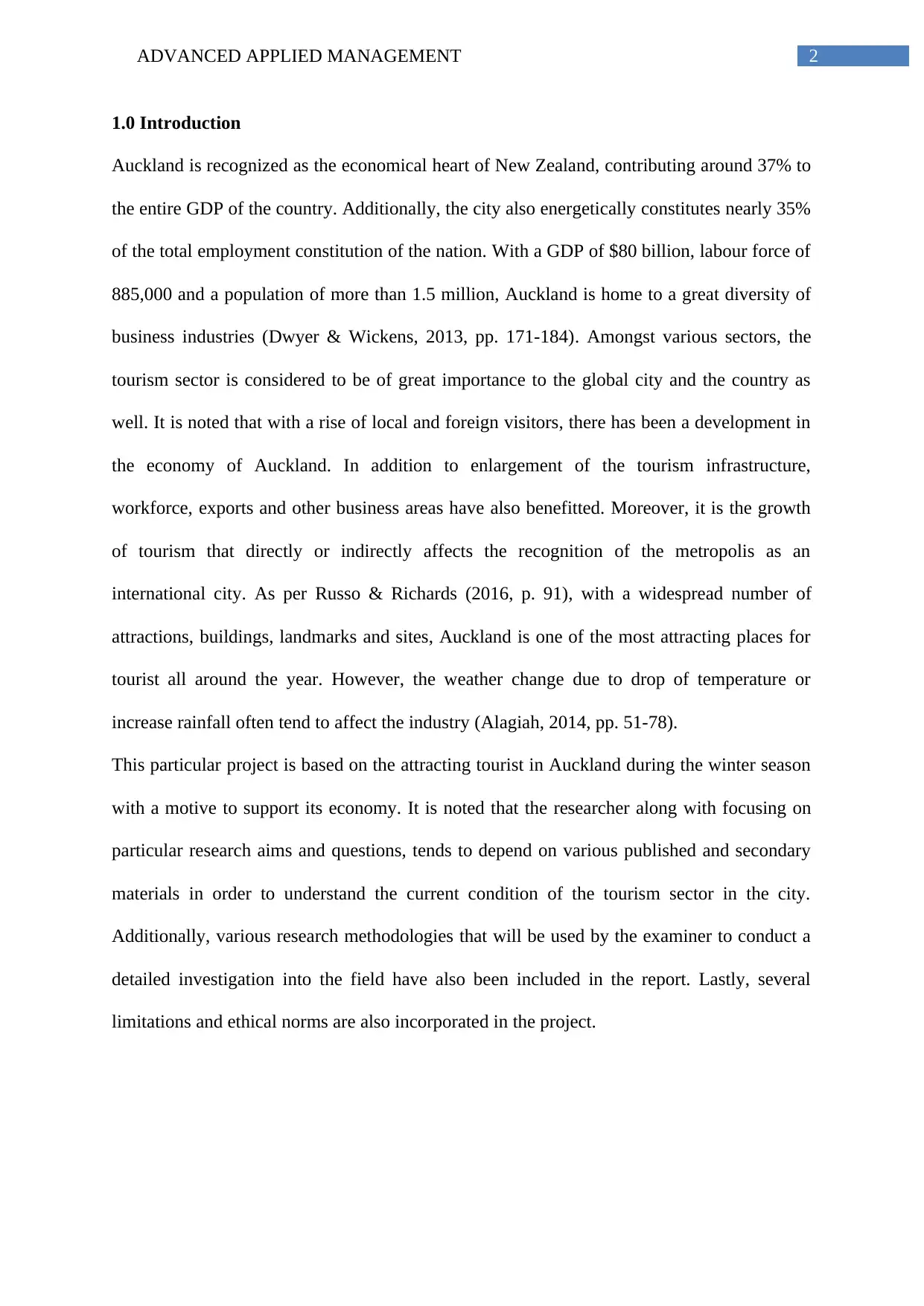
2ADVANCED APPLIED MANAGEMENT
1.0 Introduction
Auckland is recognized as the economical heart of New Zealand, contributing around 37% to
the entire GDP of the country. Additionally, the city also energetically constitutes nearly 35%
of the total employment constitution of the nation. With a GDP of $80 billion, labour force of
885,000 and a population of more than 1.5 million, Auckland is home to a great diversity of
business industries (Dwyer & Wickens, 2013, pp. 171-184). Amongst various sectors, the
tourism sector is considered to be of great importance to the global city and the country as
well. It is noted that with a rise of local and foreign visitors, there has been a development in
the economy of Auckland. In addition to enlargement of the tourism infrastructure,
workforce, exports and other business areas have also benefitted. Moreover, it is the growth
of tourism that directly or indirectly affects the recognition of the metropolis as an
international city. As per Russo & Richards (2016, p. 91), with a widespread number of
attractions, buildings, landmarks and sites, Auckland is one of the most attracting places for
tourist all around the year. However, the weather change due to drop of temperature or
increase rainfall often tend to affect the industry (Alagiah, 2014, pp. 51-78).
This particular project is based on the attracting tourist in Auckland during the winter season
with a motive to support its economy. It is noted that the researcher along with focusing on
particular research aims and questions, tends to depend on various published and secondary
materials in order to understand the current condition of the tourism sector in the city.
Additionally, various research methodologies that will be used by the examiner to conduct a
detailed investigation into the field have also been included in the report. Lastly, several
limitations and ethical norms are also incorporated in the project.
1.0 Introduction
Auckland is recognized as the economical heart of New Zealand, contributing around 37% to
the entire GDP of the country. Additionally, the city also energetically constitutes nearly 35%
of the total employment constitution of the nation. With a GDP of $80 billion, labour force of
885,000 and a population of more than 1.5 million, Auckland is home to a great diversity of
business industries (Dwyer & Wickens, 2013, pp. 171-184). Amongst various sectors, the
tourism sector is considered to be of great importance to the global city and the country as
well. It is noted that with a rise of local and foreign visitors, there has been a development in
the economy of Auckland. In addition to enlargement of the tourism infrastructure,
workforce, exports and other business areas have also benefitted. Moreover, it is the growth
of tourism that directly or indirectly affects the recognition of the metropolis as an
international city. As per Russo & Richards (2016, p. 91), with a widespread number of
attractions, buildings, landmarks and sites, Auckland is one of the most attracting places for
tourist all around the year. However, the weather change due to drop of temperature or
increase rainfall often tend to affect the industry (Alagiah, 2014, pp. 51-78).
This particular project is based on the attracting tourist in Auckland during the winter season
with a motive to support its economy. It is noted that the researcher along with focusing on
particular research aims and questions, tends to depend on various published and secondary
materials in order to understand the current condition of the tourism sector in the city.
Additionally, various research methodologies that will be used by the examiner to conduct a
detailed investigation into the field have also been included in the report. Lastly, several
limitations and ethical norms are also incorporated in the project.
⊘ This is a preview!⊘
Do you want full access?
Subscribe today to unlock all pages.

Trusted by 1+ million students worldwide
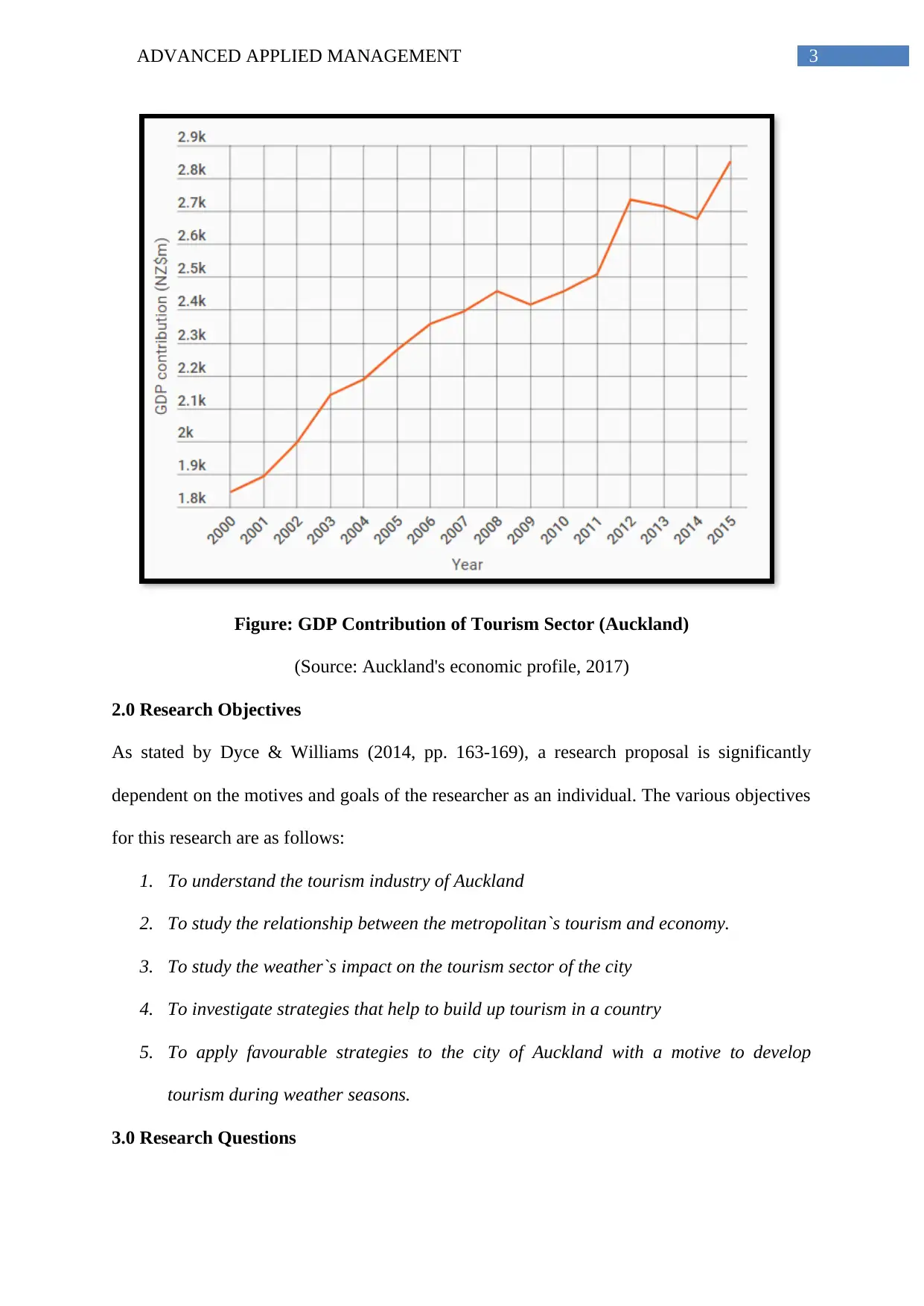
3ADVANCED APPLIED MANAGEMENT
Figure: GDP Contribution of Tourism Sector (Auckland)
(Source: Auckland's economic profile, 2017)
2.0 Research Objectives
As stated by Dyce & Williams (2014, pp. 163-169), a research proposal is significantly
dependent on the motives and goals of the researcher as an individual. The various objectives
for this research are as follows:
1. To understand the tourism industry of Auckland
2. To study the relationship between the metropolitan`s tourism and economy.
3. To study the weather`s impact on the tourism sector of the city
4. To investigate strategies that help to build up tourism in a country
5. To apply favourable strategies to the city of Auckland with a motive to develop
tourism during weather seasons.
3.0 Research Questions
Figure: GDP Contribution of Tourism Sector (Auckland)
(Source: Auckland's economic profile, 2017)
2.0 Research Objectives
As stated by Dyce & Williams (2014, pp. 163-169), a research proposal is significantly
dependent on the motives and goals of the researcher as an individual. The various objectives
for this research are as follows:
1. To understand the tourism industry of Auckland
2. To study the relationship between the metropolitan`s tourism and economy.
3. To study the weather`s impact on the tourism sector of the city
4. To investigate strategies that help to build up tourism in a country
5. To apply favourable strategies to the city of Auckland with a motive to develop
tourism during weather seasons.
3.0 Research Questions
Paraphrase This Document
Need a fresh take? Get an instant paraphrase of this document with our AI Paraphraser
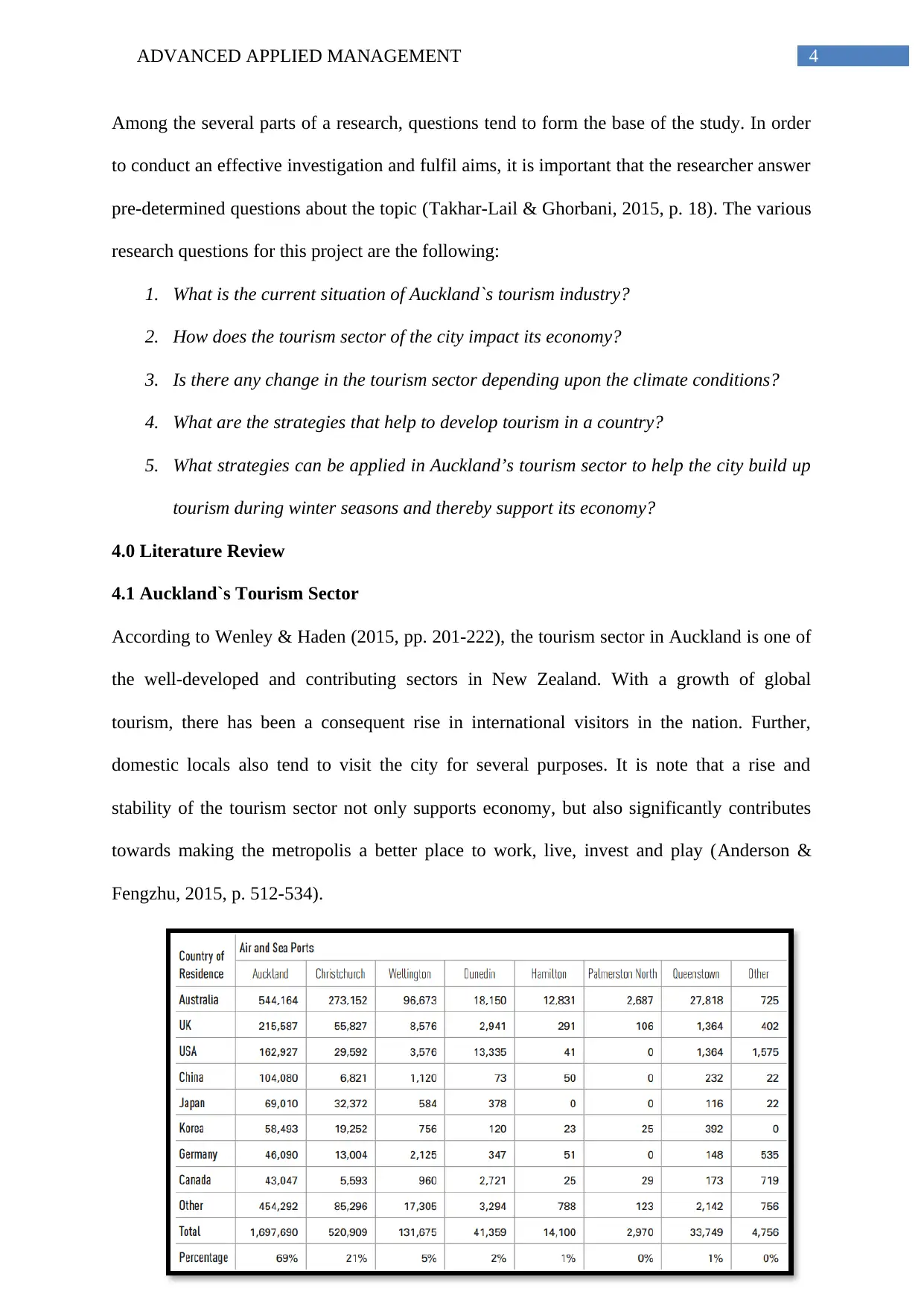
4ADVANCED APPLIED MANAGEMENT
Among the several parts of a research, questions tend to form the base of the study. In order
to conduct an effective investigation and fulfil aims, it is important that the researcher answer
pre-determined questions about the topic (Takhar-Lail & Ghorbani, 2015, p. 18). The various
research questions for this project are the following:
1. What is the current situation of Auckland`s tourism industry?
2. How does the tourism sector of the city impact its economy?
3. Is there any change in the tourism sector depending upon the climate conditions?
4. What are the strategies that help to develop tourism in a country?
5. What strategies can be applied in Auckland’s tourism sector to help the city build up
tourism during winter seasons and thereby support its economy?
4.0 Literature Review
4.1 Auckland`s Tourism Sector
According to Wenley & Haden (2015, pp. 201-222), the tourism sector in Auckland is one of
the well-developed and contributing sectors in New Zealand. With a growth of global
tourism, there has been a consequent rise in international visitors in the nation. Further,
domestic locals also tend to visit the city for several purposes. It is note that a rise and
stability of the tourism sector not only supports economy, but also significantly contributes
towards making the metropolis a better place to work, live, invest and play (Anderson &
Fengzhu, 2015, p. 512-534).
Among the several parts of a research, questions tend to form the base of the study. In order
to conduct an effective investigation and fulfil aims, it is important that the researcher answer
pre-determined questions about the topic (Takhar-Lail & Ghorbani, 2015, p. 18). The various
research questions for this project are the following:
1. What is the current situation of Auckland`s tourism industry?
2. How does the tourism sector of the city impact its economy?
3. Is there any change in the tourism sector depending upon the climate conditions?
4. What are the strategies that help to develop tourism in a country?
5. What strategies can be applied in Auckland’s tourism sector to help the city build up
tourism during winter seasons and thereby support its economy?
4.0 Literature Review
4.1 Auckland`s Tourism Sector
According to Wenley & Haden (2015, pp. 201-222), the tourism sector in Auckland is one of
the well-developed and contributing sectors in New Zealand. With a growth of global
tourism, there has been a consequent rise in international visitors in the nation. Further,
domestic locals also tend to visit the city for several purposes. It is note that a rise and
stability of the tourism sector not only supports economy, but also significantly contributes
towards making the metropolis a better place to work, live, invest and play (Anderson &
Fengzhu, 2015, p. 512-534).
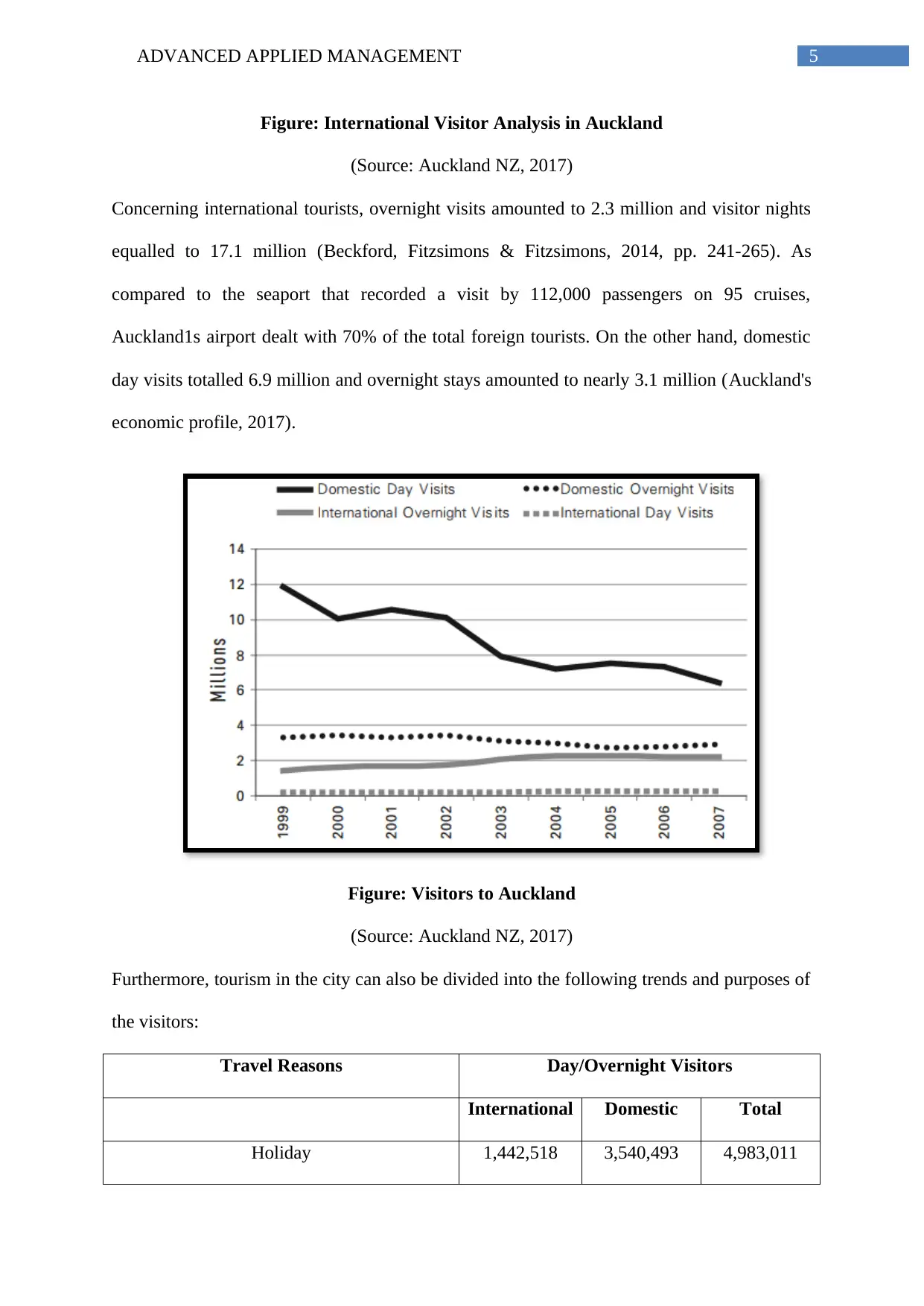
5ADVANCED APPLIED MANAGEMENT
Figure: International Visitor Analysis in Auckland
(Source: Auckland NZ, 2017)
Concerning international tourists, overnight visits amounted to 2.3 million and visitor nights
equalled to 17.1 million (Beckford, Fitzsimons & Fitzsimons, 2014, pp. 241-265). As
compared to the seaport that recorded a visit by 112,000 passengers on 95 cruises,
Auckland1s airport dealt with 70% of the total foreign tourists. On the other hand, domestic
day visits totalled 6.9 million and overnight stays amounted to nearly 3.1 million (Auckland's
economic profile, 2017).
Figure: Visitors to Auckland
(Source: Auckland NZ, 2017)
Furthermore, tourism in the city can also be divided into the following trends and purposes of
the visitors:
Travel Reasons Day/Overnight Visitors
International Domestic Total
Holiday 1,442,518 3,540,493 4,983,011
Figure: International Visitor Analysis in Auckland
(Source: Auckland NZ, 2017)
Concerning international tourists, overnight visits amounted to 2.3 million and visitor nights
equalled to 17.1 million (Beckford, Fitzsimons & Fitzsimons, 2014, pp. 241-265). As
compared to the seaport that recorded a visit by 112,000 passengers on 95 cruises,
Auckland1s airport dealt with 70% of the total foreign tourists. On the other hand, domestic
day visits totalled 6.9 million and overnight stays amounted to nearly 3.1 million (Auckland's
economic profile, 2017).
Figure: Visitors to Auckland
(Source: Auckland NZ, 2017)
Furthermore, tourism in the city can also be divided into the following trends and purposes of
the visitors:
Travel Reasons Day/Overnight Visitors
International Domestic Total
Holiday 1,442,518 3,540,493 4,983,011
⊘ This is a preview!⊘
Do you want full access?
Subscribe today to unlock all pages.

Trusted by 1+ million students worldwide
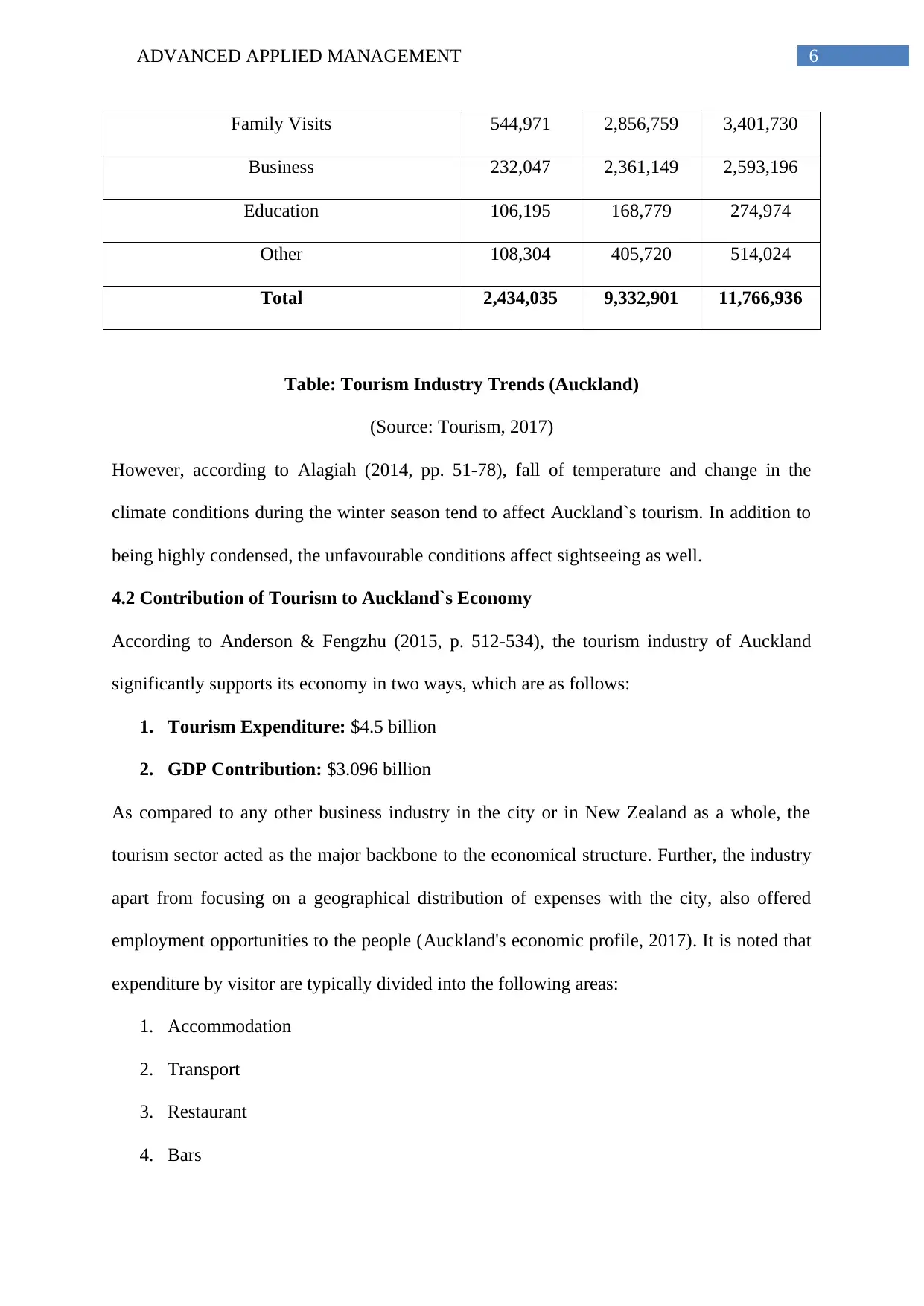
6ADVANCED APPLIED MANAGEMENT
Family Visits 544,971 2,856,759 3,401,730
Business 232,047 2,361,149 2,593,196
Education 106,195 168,779 274,974
Other 108,304 405,720 514,024
Total 2,434,035 9,332,901 11,766,936
Table: Tourism Industry Trends (Auckland)
(Source: Tourism, 2017)
However, according to Alagiah (2014, pp. 51-78), fall of temperature and change in the
climate conditions during the winter season tend to affect Auckland`s tourism. In addition to
being highly condensed, the unfavourable conditions affect sightseeing as well.
4.2 Contribution of Tourism to Auckland`s Economy
According to Anderson & Fengzhu (2015, p. 512-534), the tourism industry of Auckland
significantly supports its economy in two ways, which are as follows:
1. Tourism Expenditure: $4.5 billion
2. GDP Contribution: $3.096 billion
As compared to any other business industry in the city or in New Zealand as a whole, the
tourism sector acted as the major backbone to the economical structure. Further, the industry
apart from focusing on a geographical distribution of expenses with the city, also offered
employment opportunities to the people (Auckland's economic profile, 2017). It is noted that
expenditure by visitor are typically divided into the following areas:
1. Accommodation
2. Transport
3. Restaurant
4. Bars
Family Visits 544,971 2,856,759 3,401,730
Business 232,047 2,361,149 2,593,196
Education 106,195 168,779 274,974
Other 108,304 405,720 514,024
Total 2,434,035 9,332,901 11,766,936
Table: Tourism Industry Trends (Auckland)
(Source: Tourism, 2017)
However, according to Alagiah (2014, pp. 51-78), fall of temperature and change in the
climate conditions during the winter season tend to affect Auckland`s tourism. In addition to
being highly condensed, the unfavourable conditions affect sightseeing as well.
4.2 Contribution of Tourism to Auckland`s Economy
According to Anderson & Fengzhu (2015, p. 512-534), the tourism industry of Auckland
significantly supports its economy in two ways, which are as follows:
1. Tourism Expenditure: $4.5 billion
2. GDP Contribution: $3.096 billion
As compared to any other business industry in the city or in New Zealand as a whole, the
tourism sector acted as the major backbone to the economical structure. Further, the industry
apart from focusing on a geographical distribution of expenses with the city, also offered
employment opportunities to the people (Auckland's economic profile, 2017). It is noted that
expenditure by visitor are typically divided into the following areas:
1. Accommodation
2. Transport
3. Restaurant
4. Bars
Paraphrase This Document
Need a fresh take? Get an instant paraphrase of this document with our AI Paraphraser
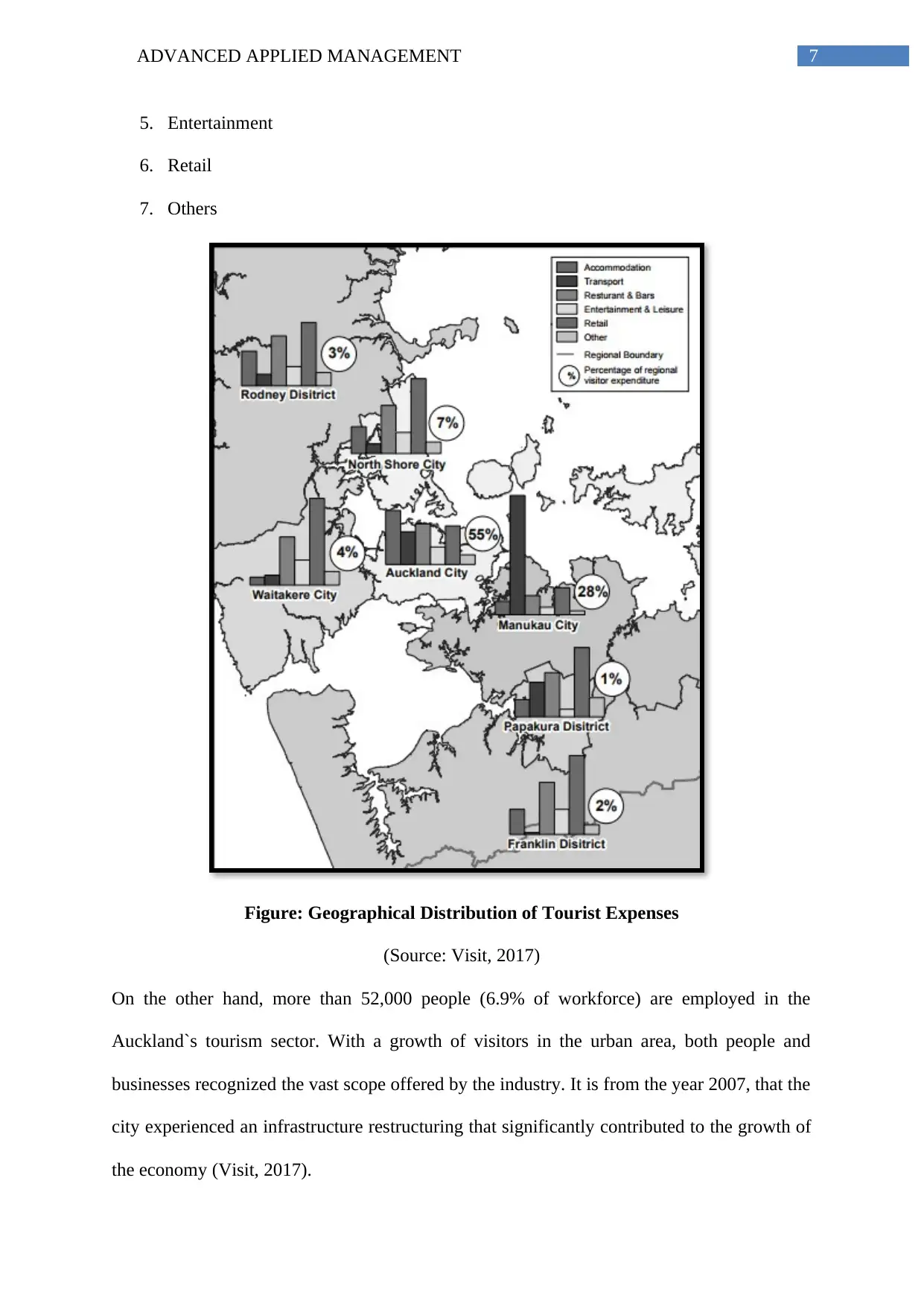
7ADVANCED APPLIED MANAGEMENT
5. Entertainment
6. Retail
7. Others
Figure: Geographical Distribution of Tourist Expenses
(Source: Visit, 2017)
On the other hand, more than 52,000 people (6.9% of workforce) are employed in the
Auckland`s tourism sector. With a growth of visitors in the urban area, both people and
businesses recognized the vast scope offered by the industry. It is from the year 2007, that the
city experienced an infrastructure restructuring that significantly contributed to the growth of
the economy (Visit, 2017).
5. Entertainment
6. Retail
7. Others
Figure: Geographical Distribution of Tourist Expenses
(Source: Visit, 2017)
On the other hand, more than 52,000 people (6.9% of workforce) are employed in the
Auckland`s tourism sector. With a growth of visitors in the urban area, both people and
businesses recognized the vast scope offered by the industry. It is from the year 2007, that the
city experienced an infrastructure restructuring that significantly contributed to the growth of
the economy (Visit, 2017).
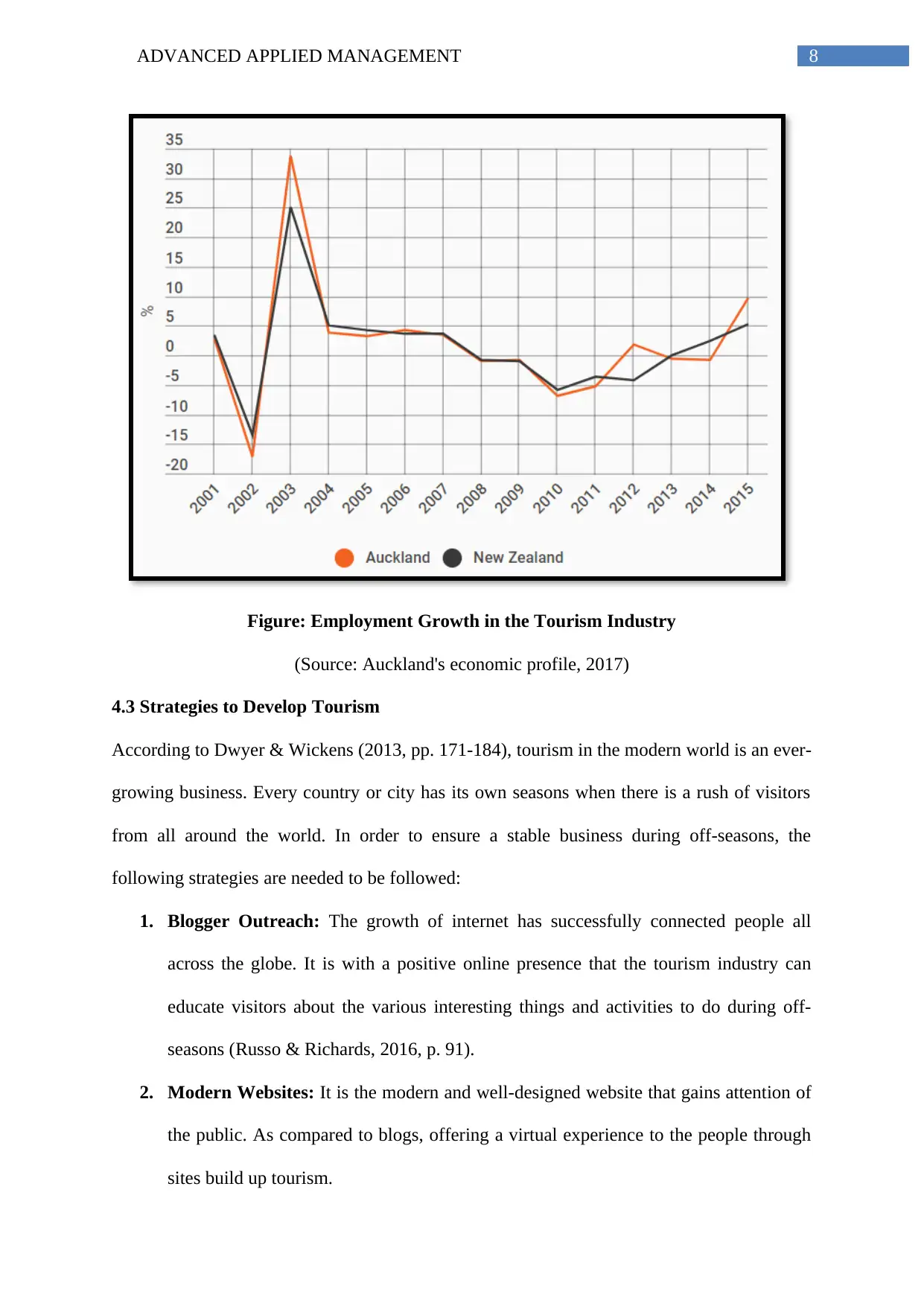
8ADVANCED APPLIED MANAGEMENT
Figure: Employment Growth in the Tourism Industry
(Source: Auckland's economic profile, 2017)
4.3 Strategies to Develop Tourism
According to Dwyer & Wickens (2013, pp. 171-184), tourism in the modern world is an ever-
growing business. Every country or city has its own seasons when there is a rush of visitors
from all around the world. In order to ensure a stable business during off-seasons, the
following strategies are needed to be followed:
1. Blogger Outreach: The growth of internet has successfully connected people all
across the globe. It is with a positive online presence that the tourism industry can
educate visitors about the various interesting things and activities to do during off-
seasons (Russo & Richards, 2016, p. 91).
2. Modern Websites: It is the modern and well-designed website that gains attention of
the public. As compared to blogs, offering a virtual experience to the people through
sites build up tourism.
Figure: Employment Growth in the Tourism Industry
(Source: Auckland's economic profile, 2017)
4.3 Strategies to Develop Tourism
According to Dwyer & Wickens (2013, pp. 171-184), tourism in the modern world is an ever-
growing business. Every country or city has its own seasons when there is a rush of visitors
from all around the world. In order to ensure a stable business during off-seasons, the
following strategies are needed to be followed:
1. Blogger Outreach: The growth of internet has successfully connected people all
across the globe. It is with a positive online presence that the tourism industry can
educate visitors about the various interesting things and activities to do during off-
seasons (Russo & Richards, 2016, p. 91).
2. Modern Websites: It is the modern and well-designed website that gains attention of
the public. As compared to blogs, offering a virtual experience to the people through
sites build up tourism.
⊘ This is a preview!⊘
Do you want full access?
Subscribe today to unlock all pages.

Trusted by 1+ million students worldwide
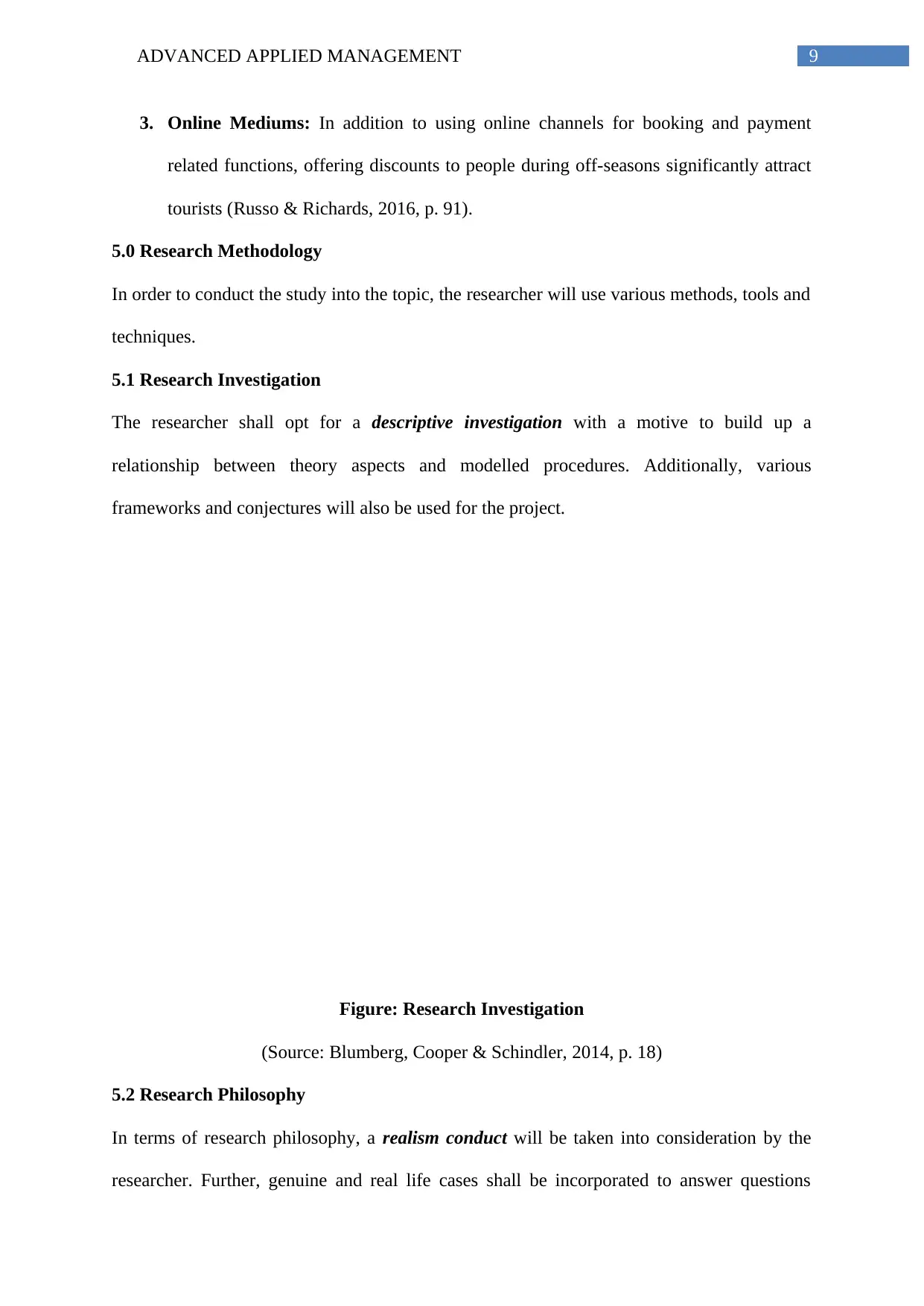
9ADVANCED APPLIED MANAGEMENT
3. Online Mediums: In addition to using online channels for booking and payment
related functions, offering discounts to people during off-seasons significantly attract
tourists (Russo & Richards, 2016, p. 91).
5.0 Research Methodology
In order to conduct the study into the topic, the researcher will use various methods, tools and
techniques.
5.1 Research Investigation
The researcher shall opt for a descriptive investigation with a motive to build up a
relationship between theory aspects and modelled procedures. Additionally, various
frameworks and conjectures will also be used for the project.
Figure: Research Investigation
(Source: Blumberg, Cooper & Schindler, 2014, p. 18)
5.2 Research Philosophy
In terms of research philosophy, a realism conduct will be taken into consideration by the
researcher. Further, genuine and real life cases shall be incorporated to answer questions
ExploratoryHypothesisDESCRIPTIVE
3. Online Mediums: In addition to using online channels for booking and payment
related functions, offering discounts to people during off-seasons significantly attract
tourists (Russo & Richards, 2016, p. 91).
5.0 Research Methodology
In order to conduct the study into the topic, the researcher will use various methods, tools and
techniques.
5.1 Research Investigation
The researcher shall opt for a descriptive investigation with a motive to build up a
relationship between theory aspects and modelled procedures. Additionally, various
frameworks and conjectures will also be used for the project.
Figure: Research Investigation
(Source: Blumberg, Cooper & Schindler, 2014, p. 18)
5.2 Research Philosophy
In terms of research philosophy, a realism conduct will be taken into consideration by the
researcher. Further, genuine and real life cases shall be incorporated to answer questions
ExploratoryHypothesisDESCRIPTIVE
Paraphrase This Document
Need a fresh take? Get an instant paraphrase of this document with our AI Paraphraser
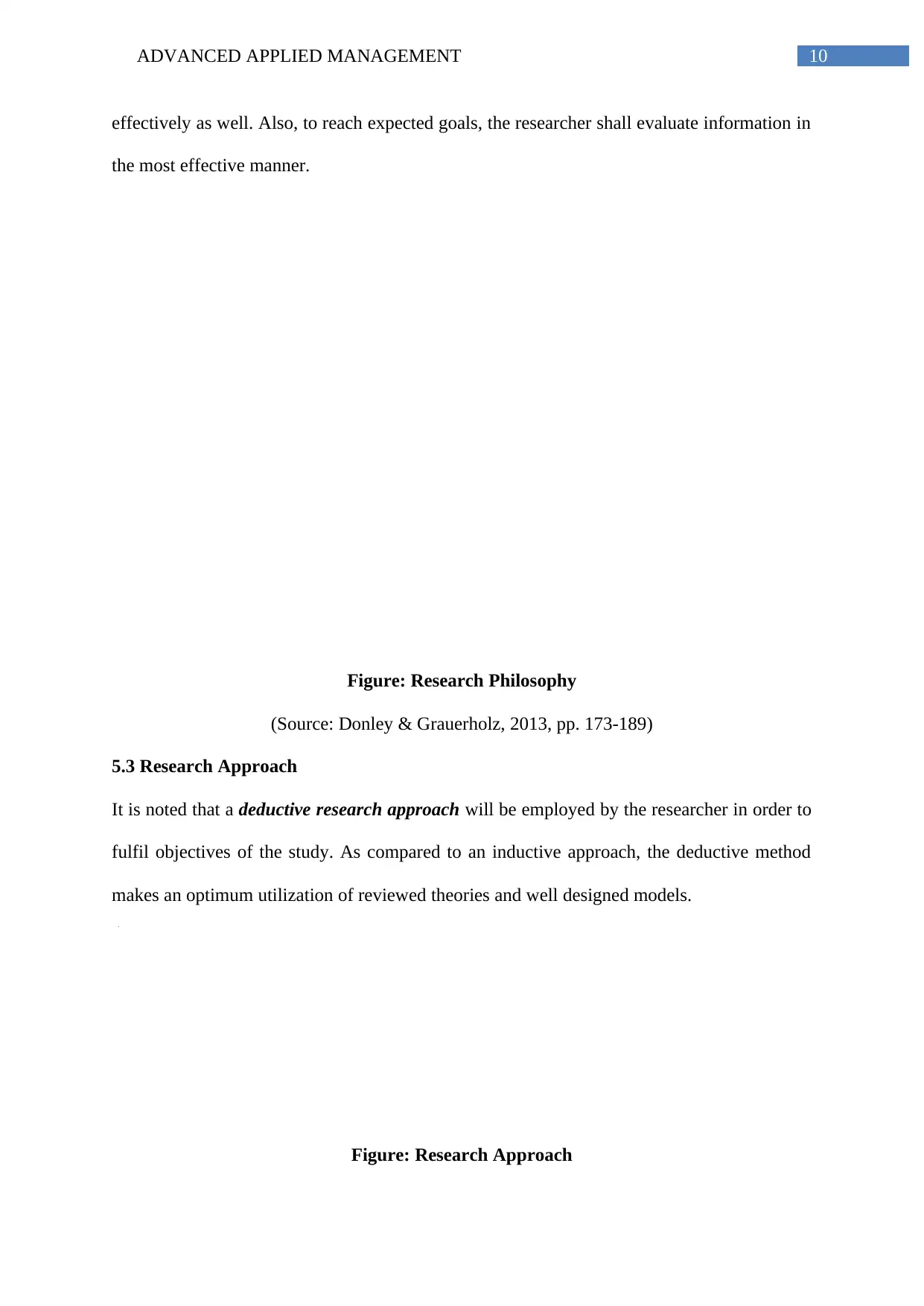
10ADVANCED APPLIED MANAGEMENT
effectively as well. Also, to reach expected goals, the researcher shall evaluate information in
the most effective manner.
Figure: Research Philosophy
(Source: Donley & Grauerholz, 2013, pp. 173-189)
5.3 Research Approach
It is noted that a deductive research approach will be employed by the researcher in order to
fulfil objectives of the study. As compared to an inductive approach, the deductive method
makes an optimum utilization of reviewed theories and well designed models.
Figure: Research Approach
PositivsmInterpretiveRealism
effectively as well. Also, to reach expected goals, the researcher shall evaluate information in
the most effective manner.
Figure: Research Philosophy
(Source: Donley & Grauerholz, 2013, pp. 173-189)
5.3 Research Approach
It is noted that a deductive research approach will be employed by the researcher in order to
fulfil objectives of the study. As compared to an inductive approach, the deductive method
makes an optimum utilization of reviewed theories and well designed models.
Figure: Research Approach
PositivsmInterpretiveRealism
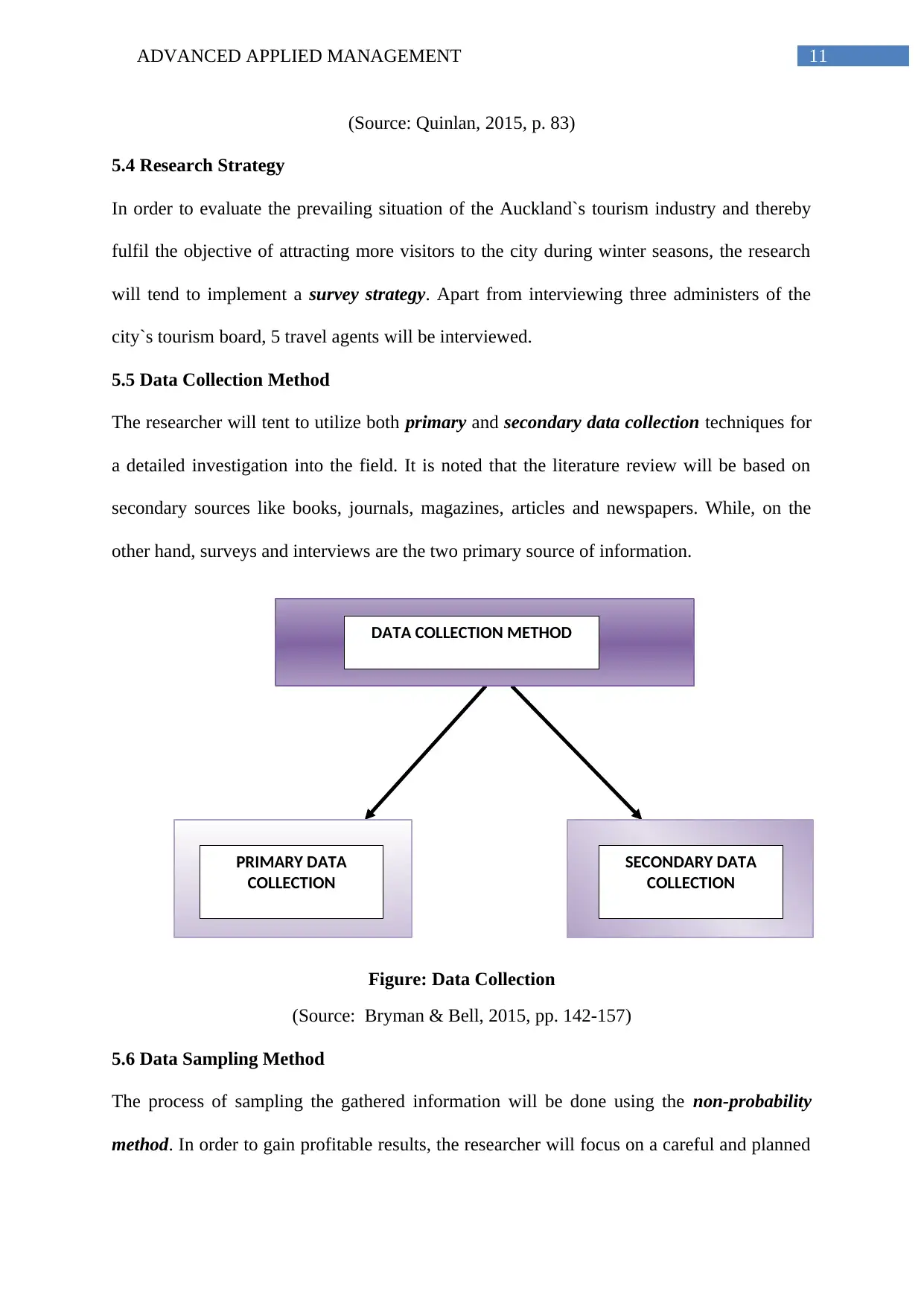
11ADVANCED APPLIED MANAGEMENT
DATA COLLECTION METHOD
PRIMARY DATA
COLLECTION
SECONDARY DATA
COLLECTION
(Source: Quinlan, 2015, p. 83)
5.4 Research Strategy
In order to evaluate the prevailing situation of the Auckland`s tourism industry and thereby
fulfil the objective of attracting more visitors to the city during winter seasons, the research
will tend to implement a survey strategy. Apart from interviewing three administers of the
city`s tourism board, 5 travel agents will be interviewed.
5.5 Data Collection Method
The researcher will tent to utilize both primary and secondary data collection techniques for
a detailed investigation into the field. It is noted that the literature review will be based on
secondary sources like books, journals, magazines, articles and newspapers. While, on the
other hand, surveys and interviews are the two primary source of information.
Figure: Data Collection
(Source: Bryman & Bell, 2015, pp. 142-157)
5.6 Data Sampling Method
The process of sampling the gathered information will be done using the non-probability
method. In order to gain profitable results, the researcher will focus on a careful and planned
DATA COLLECTION METHOD
PRIMARY DATA
COLLECTION
SECONDARY DATA
COLLECTION
(Source: Quinlan, 2015, p. 83)
5.4 Research Strategy
In order to evaluate the prevailing situation of the Auckland`s tourism industry and thereby
fulfil the objective of attracting more visitors to the city during winter seasons, the research
will tend to implement a survey strategy. Apart from interviewing three administers of the
city`s tourism board, 5 travel agents will be interviewed.
5.5 Data Collection Method
The researcher will tent to utilize both primary and secondary data collection techniques for
a detailed investigation into the field. It is noted that the literature review will be based on
secondary sources like books, journals, magazines, articles and newspapers. While, on the
other hand, surveys and interviews are the two primary source of information.
Figure: Data Collection
(Source: Bryman & Bell, 2015, pp. 142-157)
5.6 Data Sampling Method
The process of sampling the gathered information will be done using the non-probability
method. In order to gain profitable results, the researcher will focus on a careful and planned
⊘ This is a preview!⊘
Do you want full access?
Subscribe today to unlock all pages.

Trusted by 1+ million students worldwide
1 out of 17
Related Documents
Your All-in-One AI-Powered Toolkit for Academic Success.
+13062052269
info@desklib.com
Available 24*7 on WhatsApp / Email
![[object Object]](/_next/static/media/star-bottom.7253800d.svg)
Unlock your academic potential
Copyright © 2020–2025 A2Z Services. All Rights Reserved. Developed and managed by ZUCOL.




